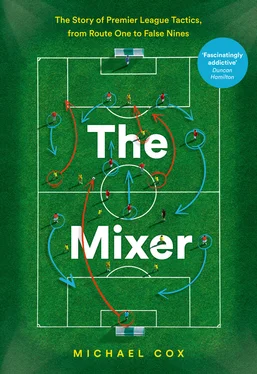Bergkamp and Zola were unquestionably top-class footballers. Bergkamp had finished second in the 1993 Ballon d’Or, one place ahead of Cantona and behind only Roberto Baggio, the greatest number 10 of this generation. Meanwhile, Zola finished sixth in 1995. They were revered across Europe because of their creativity, their selflessness and the spatial awareness that allowed them to thrive between the lines. Both arrived from Serie A, with Bergkamp – whose influence upon Arsenal would become clear later on – outlining why he discovered the Premier League suited him. ‘English defences always played a back four, with one line, which meant they had to defend the space behind. In Italy they had the libero [a sweeper who would cover behind his fellow defenders], but the English had two central defenders against two strikers, so they couldn’t really cover each other. As an attacker I liked that because it meant you could play in between the lines. They couldn’t come off their line. So I used that.’
Zola discovered something similar. ‘At the beginning, the open English football really helped me, as I was coming from tighter marking in Serie A,’ he explained. Zola only arrived in England because his former club, Parma, had an inflexible coach who was unwilling to deviate from 4–4–2. Surprisingly, this was Carlo Ancelotti, who would later become the go-to manager for continental giants awash with superstars – including Chelsea – precisely because he was flexible enough to build teams around star individuals. Back then, however, Ancelotti – who had been Italy’s assistant coach under legendary manager Arrigo Sacchi, the man who popularised a pressing 4–4–2 system – simply wouldn’t accommodate a number 10, turning down Baggio for similar reasons, and attempted to play Zola out wide. ‘I will be able to play my proper role in England,’ Zola declared upon his arrival in London.
Zola had served his apprenticeship at Napoli under the best possible mentor. ‘I learned everything from Diego Maradona,’ he admitted. While famous for his ego, Maradona was also renowned for being extremely generous with his praise of his Napoli teammates, and he loved Zola so much that, ahead of a Coppa Italia tie against Pisa, he handed the Sardinian his famous number 10 shirt, and wore number 9 instead. Zola was forced to settle for 25 at Chelsea, with Mark Hughes in his favoured 10 shirt, but it became an iconic number. Although not officially retired by Chelsea, no one has dared to wear Zola’s number 25 since his departure in 2003.
Zola’s technical ability was outstanding. His first goal was a magnificent free-kick in a 2–2 draw with Everton, and only David Beckham has scored more Premier League free-kicks. Zola confirmed his status as Chelsea’s dead-ball specialist after a training-ground competition with Dennis Wise. A sock was tied to the crossbar – both were five foot six, so this presumably involved one sitting on the other’s shoulders – and they stood outside the box and attempted to curl the ball against the sock. Zola won 10–1, and the matter was settled. Dismayed by the lack of equipment at Chelsea’s old training ground near Heathrow Airport, Zola purchased his own mock defensive wall and spent hours practising.
While Cantona was tall and physically commanding, Zola was small, slight and wore size 5 boots. He was strong for his size, however, and used his body excellently. Chelsea teammate Graeme Le Saux considered him the joint best forward he’d ever seen, along with Kenny Dalglish, at the art of shielding the ball from defenders. But more than anyone else of this era, Zola thrived upon space, a classic example being his winner in the 1997 FA Cup semi-final against Wimbledon at Highbury. Initially positioned high up against the opposition defence, Zola watched teammate Roberto Di Matteo moving between the lines, dragging Wimbledon’s right-sided centre-back Chris Perry up the pitch. Zola then sprinted into the space Perry had vacated, pulling Wimbledon’s left-sided centre-back Dean Blackwell across to cover. Di Matteo played the ball into Zola’s feet, and Chelsea’s number 25 immediately backheeled it into the zone Blackwell had vacated, changed direction, collected the ball and fired home. In a few seconds, he’d seen space, exploited it, created more space, exploited that, and scored. For a player in his mould, it was the perfect goal.
Crucially, Zola was allowed a ‘free role’ behind the main striker, in a Chelsea side formatted specifically to bring out his qualities. Centre-back Steve Clarke remembers a team talk in which the message was simply ‘get the ball to Zola’, while Wise referred to Zola as a ‘showhorse’ and labelled himself a ‘donkey’. The donkey’s job, he said, was simply to do the hard work and pass to the showhorse. ‘Historically [English sides] have been set up with two strong strikers, two sitting midfielders and two wingers,’ Zola said after his retirement. ‘You never used to play the ball through the middle. What you used to do was play the ball down the sides and cross the ball to the tall player.’ Zola, like Cantona and Bergkamp, helped to change that.
‘He’s a clever little bugger … a better player than I thought he was,’ Alex Ferguson had conceded two months earlier, after Zola scored a fine second-minute goal against Manchester United, dribbling inside from the right before finishing with his left foot. ‘I thought we could push my full-backs forward, but he was smart enough to go and play wide. He has got a good head on him.’ Later, Ryan Giggs claimed that such was Zola’s ability to find space that he was the only Premier League player United man-marked, although this often proved unsuccessful. For Chelsea’s 5–0 thrashing of United in October 1999, Ferguson was without Giggs and played Phil Neville in his place, but instructed him to play centrally, man-marking Zola. United largely nullified the Italian but left a gaping hole on their left, which meant Chelsea’s Albert Ferrer and Dan Petrescu, two right-backs in tandem, assisted the opening two goals with deep crosses.
While Premier League observers marvelled at these majestic, game-changing foreign number 10s, there was nevertheless an acknowledgement that many arrived in Britain because they had limited options elsewhere. Cantona had effectively been run out of France, Bergkamp struggled in Italy with Inter Milan, while Zola had recently turned 30, then considered the cut-off for forwards’ peak years, and admitted he only expected to play for a couple more seasons. There was a sense that the Premier League was gaining top-class players when they were on the way down. Therefore, in one respect the most significant arrival during this period was another foreign number 10: Juninho. Newly promoted Middlesbrough’s purchase of the diminutive Brazilian in 1995 was a truly remarkable transfer coup, because he was unquestionably on the way up.
Juninho had impressed on English soil that summer, when world champions Brazil competed alongside England, Sweden and Japan in the Umbro Cup, a tournament held as preparation for the following summer’s European Championships. Juninho wore Brazil’s number 10, the most iconic shirt in world football, played in a 4–3–1–2 system based around him and was inspirational in the 3–1 victory over England. He opened the scoring with a classic Brazilian ‘folha seca’ (dry leaf) free-kick, played with topspin, which surprised goalkeeper Tim Flowers with its sudden dip. Simply being allowed to take free-kicks ahead of Roberto Carlos was an achievement in itself. Brazil’s second goal, meanwhile, showcased Juninho’s playmaking skills perfectly; he received the ball between the lines, glanced up and sidefooted a through-ball into the path of another promising youngster, Brazil’s number 9, who finished confidently by rounding Flowers and converting into an empty net. It was English football’s introduction to Ronaldo, and yet everyone was talking about Juninho.
Читать дальше












